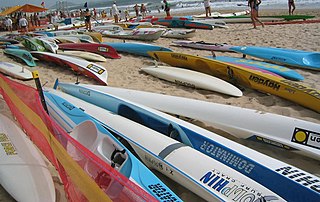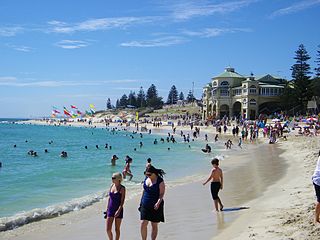
Surf lifesaving is a multifaceted social movement that comprises key aspects of voluntary lifeguard services and competitive surf sport. Originating in early 20th century Australia, the movement has expanded globally to other countries, including New Zealand, Ireland, South Africa, and the United Kingdom. Surf lifesavers in Australia are colloquially known as "Clubbies".

Sutherland Shire is a local government area in the southern region of Sydney, in the state of New South Wales, Australia. The Sutherland Shire is located just south of the Sydney CBD, and comprises an area of 370 square kilometres (140 sq mi) and as at the 2016 census and has an estimated population of 218,464. The Sutherland Shire is colloquially known as "The Shire" which has been featured in several reality television series.

Cronulla is a suburb of Sydney, in the state of New South Wales, Australia. Boasting numerous surf beaches and swimming spots, the suburb attracts both tourists and Greater Sydney residents. Cronulla is 26 kilometres south of the Sydney central business district, in the local government area of the Sutherland Shire.

Coogee is a beachside suburb in the Eastern Suburbs of Sydney, New South Wales, Australia, eight kilometres south-east of the Sydney central business district.

Maroubra is a beachside suburb in the Eastern Suburbs of Sydney, in the state of New South Wales, Australia. It is 10 kilometres south-east of the Sydney central business district in the local government area of the City of Randwick.

Little Bay is a suburb in the Eastern Suburbs of Sydney, in the state of New South Wales, Australia. Little Bay is located 14 kilometres south-east of the Sydney central business district and is part of the local government area of the City of Randwick.

Tamarama is a beachside suburb, eastern suburb of Sydney, in the state of New South Wales, Australia. Tamarama is 6 kilometres east of the Sydney central business district, in the local government area of Waverley Council.

Clovelly is a small affluent beach-side suburb in Sydney's Eastern Suburbs, in the state of New South Wales, Australia. Clovelly is located 8 kilometres south-east of the Sydney central business district.

Nippers are young surf lifesavers, usually aged between 5 and 14 years old, in clubs across Australia, New Zealand and South Africa. Unlike senior surf lifesavers, the majority of them do not patrol the beaches. The focus for Nippers tends to be on fun, and surf awareness.

Wanda Beach or Wanda is the northernmost patrolled beach at Bate Bay in Cronulla, Sydney, New South Wales, Australia. Green Hills or Green Hills Ridge is the name given to the Cronulla sand dunes, just north of Wanda.

Elouera Beach or Elouera is a patrolled beach on Bate Bay, in Cronulla, Sydney, New South Wales, Australia. The Wall is the local name given to the area between North Cronulla Beach and Elouera.

North Cronulla Beach or North Cronulla is a patrolled beach on Bate Bay, in Cronulla, Sydney New South Wales, Australia. The Wall is the local name given to the area between North Cronulla Beach and Elouera. The Alley is the local name given to the permanent rip current located at the southern end of North Cronulla Beach.

The Coogee Surf Life Saving Club is a foundation member of the surf lifesaving movement in Australia. It was founded in 1907 by a group of concerned locals and has a proud history of no lives being lost whilst its members have patrolled. Coogee SLSC celebrated its 100-year anniversary in 2007, the Year of the Lifesaver.

Cottesloe Beach is a popular beach in Cottesloe and one of the most iconic locations of Western Australia. The enduring popularity of the beach is the result of combination of factors including proximity to metropolitan Perth, accessibility by train, shelter from strong summer breezes and presence of offshore reefs making it a relatively safe swimming location. It has been recognised by the Heritage Council as a place of cultural significance since 2005. Since the beginning of the twentieth century a succession of bathing structures and hotels have been constructed in prominent locations overlooking the beach. The current beach-front structure was constructed in 1996 and is known as the Indiana Teahouse. Designed in a neotraditional architectural style it has become an internationally recognised landmark of Perth. The beach hosts the popular Rottnest Channel Swim, and Sculpture by the Sea. It attracts around 600,000 visitors per year.

Surf Life Saving Australia (SLSA) is an Australian not-for-profit community organisation that promotes water safety and provides surf rescue services.

Breamlea, Victoria, Australia, is a secluded seaside hamlet located on the south coast of the Bellarine Peninsula, 18 kilometres south of Geelong, and halfway between Barwon Heads and Torquay. It is divided between the City of Greater Geelong and the Surf Coast Shire. In the 2016 census, Breamlea had a permanent population of 162.
The club was founded in 1903 and the movement has since spread to other parts of New South Wales and the rest of the country. The club rests on indigenous land and whilst there is no clear evidence for the name or names of the Eora people who lived in what is now the Waverley area, most sources agree on the Cadigal, but some sources name the Biddigal and Birrabirragal bands as well.

The Cronulla Surf Life Saving Club, was one of the first surf clubs established in Australia in 1907. The club is located in the southern Sydney suburb of Cronulla, which had very humble beginnings in a tram carriage and today the clubhouse is housed in a magnificent art deco building on the beachfront, that was built in 1940.

Marley Beach is an unpatrolled beach in the upper Royal National Park, on the outskirts of southern Sydney, Australia. The beach is one of eleven beaches located within the territory of the Royal National Park. Marley is considered by Surf Life Saving Australia as the most hazardous unpatrolled beach in the park, and both surfing and swimming are not advised by both SLSA and the New South Wales National Parks and Wildlife Service. One of the largest beaches in the Sydney metropolitan area, Marley is also notable for the expansive sand dunes that lie behind the beach, which take up over 130,000 square meters.
The Wanda Surf Lifesaving Club was established in 1946 after World War II by a group of men who banded together, from the North Cronulla Surf Life Saving Club who were being asked to patrol this stretch of beach, being a considerable distance from the Cronulla area. The colours of Army red, Air Force blue, and Navy blue were adopted as the club colours. The club, located on Marine Esplanade, has grown in size to its current membership of over 900 male and female members, ranging in age from five-year-old Nippers to the original Founding Members.

























